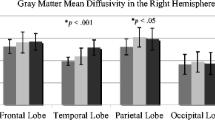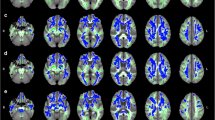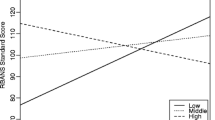Abstract
Socioeconomic status (SES) is an important reserve variable which has been shown to benefit the aging brain’s macrostructure. However, it remains unknown whether SES affects age-related changes in the brain’s white matter (WM) microstructure. Here, we used diffusion tensor imaging to explore the relationship between SES and three components of the diffusion tensor [fractional anisotropy (FA), axial diffusivity, and radial diffusivity (DR)]. Participants were 40 (16 male) cognitively normal young adults (mean age = 33.3 years, SD = 4.27) and 44 (19 male) cognitively normal community dwelling seniors (mean age = 66.2 years, SD = 7.5). Age-related FA declines were observed across a large portion of the WM skeleton. However, seniors with high SES showed lower age-related WM integrity declines in three frontal tracts: the right anterior corona radiata and bilateral portions of WM underlying the superior frontal gyri (SFG–WM). Positive SES–FA correlations were primarily driven by negative DR–SES correlations, suggesting that SES may buffer age-related declines in myelin. The functional significance of high SES in these frontal tracts was demonstrated through positive correlations with working memory performance. Possible mechanisms through which SES may attenuate the effects of age on frontal WM integrity are discussed.




Similar content being viewed by others
References
Abe O, Aoki S, Hayashi N, Yamada H, Kunimatsu A, Mori H, Yoshikawa T, Okubo T, Ohtomo K (2002) Normal aging in the central nervous system: quantitative MR diffusion-tensor analysis. Neurobiol Aging 23(3):433–441
Andersen I, Burr H, Kristensen TS, Gamborg M, Osler M, Prescott E, Diderichsen F (2004) Do factors in the psychosocial work environment mediate the effect of socioeconomic position on the risk of myocardial infarction? Study from the Copenhagen Centre for Prospective Population Studies. Occup Environ Med 61(11):886–892
Anttila T, Helkala EL, Viitanen M, Kareholt I, Fratiglioni L, Winblad B, Soininen H, Tuomilehto J, Nissinen A, Kivipelto M (2004) Alcohol drinking in middle age and subsequent risk of mild cognitive impairment and dementia in old age: a prospective population based study. BMJ 329(7465):539
Arenaza-Urquijo EM, Bosch B, Sala-Llonch R, Sole-Padulles C, Junque C, Fernandez-Espejo D, Bargallo N, Rami L, Molinuevo JL, Bartres-Faz D (2011) Specific anatomic associations between white matter integrity and cognitive reserve in normal and cognitively impaired elders. Am J Geriatr Psychiatr Off J Am Assoc Geriatri Psychiatr 19(1):33–42
Assaf Y, Pasternak O (2008) Diffusion tensor imaging (DTI)-based white matter mapping in brain research: a review. J Mol Neurosci 34(1):51–61
Babcock RL, Salthouse TA (1990) Effects of increased processing demands on age differences in working memory. Psychol Aging 5(3):421–428
Baddeley A (2000) The episodic buffer: a new component of working memory? Trends Cogn Sci 4(11):417–423
Bartres-Faz D, Sole-Padulles C, Junque C, Rami L, Bosch B, Bargallo N, Falcon C, Sanchez-Valle R, Molinuevo JL (2009) Interactions of cognitive reserve with regional brain anatomy and brain function during a working memory task in healthy elders. Biol Psychol 80(2):256–259
Basser PJ, Pierpaoli C (1996) Microstructural and physiological features of tissues elucidated by quantitative-diffusion-tensor MRI. J Magn Reson B 111(3):209–219
Basser PJ, Pajevic S, Pierpaoli C, Duda J, Aldroubi A (2000) In vivo fiber tractography using DT-MRI data. Magn Reson Med 44(4):625–632
Bradl M, Lassmann H (2010) Oligodendrocytes: biology and pathology. Acta Neuropathol 119(1):37–53
Brayne C, Ince PG, Keage HA, McKeith IG, Matthews FE, Polvikoski T, Sulkava R (2010) Education, the brain and dementia: neuroprotection or compensation? Brain J Neurol 133(Pt 8):2210–2216
Burzynska AZ, Preuschhof C, Backman L, Nyberg L, Li SC, Lindenberger U, Heekeren HR (2010) Age-related differences in white matter microstructure: region-specific patterns of diffusivity. NeuroImage 49(3):2104–2112
Cattell RB, Cattell AKS (1960) Handbook for the individual or group culture fair intelligence test. In: U.S.A. IfPaAT, editor
Chiang MC, McMahon KL, de Zubicaray GI, Martin NG, Hickie I, Toga AW, Wright MJ, Thompson PM (2011) Genetics of white matter development: a DTI study of 705 twins and their siblings aged 12 to 29. NeuroImage 54(3):2308–2317
Colcombe SJ, Erickson KI, Scalf PE, Kim JS, Prakash R, McAuley E, Elavsky S, Marquez DX, Hu L, Kramer AF (2006) Aerobic exercise training increases brain volume in aging humans. J Gerontol A Biol Sci Med Sci 61(11):1166–1170
Deary IJ, Leaper SA, Murray AD, Staff RT, Whalley LJ (2003) Cerebral white matter abnormalities and lifetime cognitive change: a 67-year follow-up of the Scottish Mental Survey of 1932. Psychol Aging 18(1):140–148
den Heijer T, Vermeer SE, van Dijk EJ, Prins ND, Koudstaal PJ, van Duijn CM, Hofman A, Breteler MM (2004) Alcohol intake in relation to brain magnetic resonance imaging findings in older persons without dementia. Am J Clin Nutr 80(4):992–997
D'Esposito M, Detre JA, Alsop DC, Shin RK, Atlas S, Grossman M (1995) The neural basis of the central executive system of working memory. Nature 378(6554):279–281
Dobbs AR, Rule BG (1989) Adult age differences in working memory. Psychol Aging 4(4):500–503
Dufouil C, Tzourio C, Brayne C, Berr C, Amouyel P, Alperovitch A (2000) Influence of apolipoprotein E genotype on the risk of cognitive deterioration in moderate drinkers and smokers. Epidemiology 11(3):280–284
Engvig A, Fjell AM, Westlye LT, Moberget T, Sundseth O, Larsen VA, Walhovd KB (2011) Memory training impacts short-term changes in aging white matter: a longitudinal diffusion tensor imaging study. Hum Brain Mapp 33(10):2390–2406
Gold BT, Powell DK, Andersen AH, Smith CD (2010) Alterations in multiple measures of white matter integrity in normal women at high risk for Alzheimer's disease. NeuroImage 52(4):1487–1494
Gold BT, Johnson NF, Powell DK, Smith CD (2012) White matter integrity and vulnerability to Alzheimer's disease: preliminary findings and future directions. Biochim Biophys Acta 1822(3):416–422
Good CD, Johnsrude IS, Ashburner J, Henson RN, Friston KJ, Frackowiak RS (2001) A voxel-based morphometric study of ageing in 465 normal adult human brains. NeuroImage 14(1 Pt 1):21–36
Groeger JA, Field D, Hammond SM (1999) Measuring memory span. Int J Psychol 34(5–6):359–363
Gyllensten L, Malmfors T (1963) Myelinization of the optic nerve and its dependence on visual function—a quantitative investigation in mice. J Embryol Exp Morpholog 11:255–266
Hackman DA, Farah MJ (2009) Socioeconomic status and the developing brain. Trends Cogn Sci 13(2):65–73
Hackman DA, Farah MJ, Meaney MJ (2010) Socioeconomic status and the brain: mechanistic insights from human and animal research. Nat Rev Neurosci 11(9):651–659
Head D, Buckner RL, Shimony JS, Williams LE, Akbudak E, Conturo TE, McAvoy M, Morris JC, Snyder AZ (2004) Differential vulnerability of anterior white matter in nondemented aging with minimal acceleration in dementia of the Alzheimer type: evidence from diffusion tensor imaging. Cereb Cortex 14(4):410–423
Hollingshead AB (1958) Social class and mental illness. Wiley, New York
Johnson NF, Kim C, Clasey JL, Bailey A, Gold BT (2012) Cardiorespiratory fitness is positively correlated with cerebral white matter integrity in healthy seniors. NeuroImage 59(2):1514–1523
Kristensen TS, Borg V, Hannerz H (2002) Socioeconomic status and psychosocial work environment: results from a Danish national study. Scand J Public Health 59:41–8
Le Bihan D (2003) Looking into the functional architecture of the brain with diffusion MRI. Nat Rev Neurosci 4(6):469–480
Lovden M, Bodammer NC, Kuhn S, Kaufmann J, Schutze H, Tempelmann C, Heinze HJ, Duzel E, Schmiedek F, Lindenberger U (2010) Experience-dependent plasticity of white-matter microstructure extends into old age. Neuropsychologia 48(13):3878–3883
Madden DJ, Whiting WL, Huettel SA, White LE, MacFall JR, Provenzale JM (2004) Diffusion tensor imaging of adult age differences in cerebral white matter: relation to response time. NeuroImage 21(3):1174–1181
Marengoni A, Fratiglioni L, Bandinelli S, Ferrucci L (2011) Socioeconomic status during lifetime and cognitive impairment no-dementia in late life: the population-based aging in the Chianti Area (InCHIANTI) Study. J Alzheimers Dis JAD 24(3):559–568
Omlin FX (1997) Optic disc and optic nerve of the blind cape mole-rat (Georychus capensis): a proposed model for naturally occurring reactive gliosis. Brain Res Bull 44(5):627–632
O'Sullivan M, Jones DK, Summers PE, Morris RG, Williams SC, Markus HS (2001) Evidence for cortical "disconnection" as a mechanism of age-related cognitive decline. Neurology 57(4):632–638
Park DC, Hertzog C, Kidder DP, Morrell RW, Mayhorn CB (1997) Effect of age on event-based and time-based prospective memory. Psychol Aging 12(2):314–327
Pfefferbaum A, Sullivan EV, Hedehus M, Lim KO, Adalsteinsson E, Moseley M (2000) Age-related decline in brain white matter anisotropy measured with spatially corrected echo-planar diffusion tensor imaging. Magn Reson Med 44(2):259–268
Pierpaoli C, Jezzard P, Basser PJ, Barnett A, Di Chiro G (1996) Diffusion tensor MR imaging of the human brain. Radiology 201(3):637–648
Rueckert D, Sonoda LI, Hayes C, Hill DL, Leach MO, Hawkes DJ (1999) Nonrigid registration using free-form deformations: application to breast MR images. IEEE Trans Med Imaging 18(8):712–721
Salat DH, Tuch DS, Greve DN, van der Kouwe AJ, Hevelone ND, Zaleta AK, Rosen BR, Fischl B, Corkin S, Rosas HD, Dale AM (2005a) Age-related alterations in white matter microstructure measured by diffusion tensor imaging. Neurobiol Aging 26(8):1215–1227
Salat DH, Tuch DS, Hevelone ND, Fischl B, Corkin S, Rosas HD, Dale AM (2005b) Age-related changes in prefrontal white matter measured by diffusion tensor imaging. Ann N Y Acad Sci 1064:37–49
Salmon E, Van der Linden M, Collette F, Delfiore G, Maquet P, Degueldre C, Luxen A, Franck G (1996) Regional brain activity during working memory tasks. Brain J Neurol 119(Pt 5):1617–1625
Satz P (1993) Brain reserve capacity on symptom onset after brain injury: a formation and review of evidence for threshold theory. Neuropsychology 7(3):273–295
Schretlen D, Pearlson GD, Anthony JC, Aylward EH, Augustine AM, Davis A, Barta P (2000) Elucidating the contributions of processing speed, executive ability, and frontal lobe volume to normal age-related differences in fluid intelligence. J Int Neuropsychol Soc: JINS 6(1):52–61
Sen PN, Basser PJ (2005) A model for diffusion in white matter in the brain. Biophys J 89(5):2927–2938
Singh-Manoux A, Marmot MG, Glymour M, Sabia S, Kivimaki M, Dugravot A (2011) Does cognitive reserve shape cognitive decline? Ann Neurol 70(2):296–304
Smith SM, Jenkinson M, Johansen-Berg H, Rueckert D, Nichols TE, Mackay CE, Watkins KE, Ciccarelli O, Cader MZ, Matthews PM, Behrens TE (2006) Tract-based spatial statistics: voxelwise analysis of multi-subject diffusion data. NeuroImage 31(4):1487–1505
Smith CD, Chebrolu H, Wekstein DR, Schmitt FA, Markesbery WR (2007) Age and gender effects on human brain anatomy: a voxel-based morphometric study in healthy elderly. Neurobiol Aging 28(7):1075–1087
Smith CD, Chebrolu H, Andersen AH, Powell DA, Lovell MA, Xiong S, Gold BT (2010) White matter diffusion alterations in normal women at risk of Alzheimer's disease. Neurobiol Aging 31(7):1122–1131
Sole-Padulles C, Bartres-Faz D, Junque C, Vendrell P, Rami L, Clemente IC, Bosch B, Villar A, Bargallo N, Jurado MA, Barrios M, Molinuevo JL (2009) Brain structure and function related to cognitive reserve variables in normal aging, mild cognitive impairment and Alzheimer's disease. Neurobiol Aging 30(7):1114–1124
Song SK, Sun SW, Ramsbottom MJ, Chang C, Russell J, Cross AH (2002) Dysmyelination revealed through MRI as increased radial (but unchanged axial) diffusion of water. NeuroImage 17(3):1429–1436
Song SK, Yoshino J, Le TQ, Lin SJ, Sun SW, Cross AH, Armstrong RC (2005) Demyelination increases radial diffusivity in corpus callosum of mouse brain. NeuroImage 26(1):132–140
Stern Y (2009) Cognitive reserve. Neuropsychologia 47(10):2015–2028
Stern Y, Gurland B, Tatemichi TK, Tang MX, Wilder D, Mayeux R (1994) Influence of education and occupation on the incidence of Alzheimer's disease. JAMA: J Am Med Assoc 271(13):1004–1010
Stern Y, Alexander GE, Prohovnik I, Stricks L, Link B, Lennon MC, Mayeux R (1995a) Relationship between lifetime occupation and parietal flow: implications for a reserve against Alzheimer's disease pathology. Neurology 45(1):55–60
Stern Y, Tang MX, Denaro J, Mayeux R (1995b) Increased risk of mortality in Alzheimer's disease patients with more advanced educational and occupational attainment. Ann Neurol 37(5):590–595
Teipel SJ, Meindl T, Wagner M, Kohl T, Burger K, Reiser MF, Herpertz S, Moller HJ, Hampel H (2009) White matter microstructure in relation to education in aging and Alzheimer's disease. J Alzheimers Dis: JAD 17(3):571–583
Valenzuela MJ, Sachdev P (2006) Brain reserve and dementia: a systematic review. Psychol Med 36(4):441–454
Wechsler DS (1997) Wechsler adult intelligence scale, 3rd edn. (WAIS-3®). Harcourt Assessment, San Antonio
Wheeler-Kingshott CA, Cercignani M (2009) About "axial" and "radial" diffusivities. Mag Reson Med: Off J Soc Mag Reson Med / Soc Mag Reson Med 61(5):1255–1260
Wiegersma S, Meertse K (1990) Subjective ordering, working memory, and aging. Exp Aging Res 16(1–2):73–77
Acknowledgments
This study was supported by NIH grant AG033036 and NSF grant BCS 0814302. We thank Sara E. Cilles for her assistance in recruiting, scanning, and testing participants. In addition, we gratefully acknowledge our collaborators at the Sanders-Brown Center on Aging at the University of Kentucky.
Author information
Authors and Affiliations
Corresponding author
About this article
Cite this article
Johnson, N.F., Kim, C. & Gold, B.T. Socioeconomic status is positively correlated with frontal white matter integrity in aging. AGE 35, 2045–2056 (2013). https://doi.org/10.1007/s11357-012-9493-8
Received:
Accepted:
Published:
Issue Date:
DOI: https://doi.org/10.1007/s11357-012-9493-8




